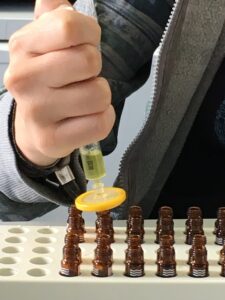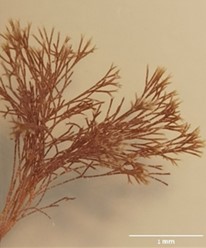Cannabis Sativa L.
The use of the cannabis plant for medicinal purposes dates back thousands of years in various cultures around the world. In recent years there has been a resurgence of interest in the plant as its therapeutic properties are becoming better understood. These properties are attributed to its naturally-occurring unique family of secondary metabolites called phytocannabinoids (phyto – plant-derived). The major and best-studied cannabinoids are the psychoactive (−)-trans-Δ9-tetrahydrocannabinol (THC) and cannabidiol (CBD). However, cannabis is not a single drug; it is a versatile plant with a complex array of compounds that contribute to its effects beyond just THC and CBD. These are just two of over 140 phytocannabinoids, as well as a mix of terpenoids, flavonoids, and other compounds with potential therapeutic activities. Moreover, hundreds of cannabis cultivars and hybrids exist worldwide, each with a unique and distinct chemical profile, and it is the interplay between these molecules from the plant and the endocannabinoid system in the body that determines the ultimate therapeutic response and associated adverse effects.
 As medical cannabis and its major cannabinoids gain momentum for various medical purposes, it becomes crucial to identify which specific metabolites are responsible for each therapeutic effect, as well as their safety and the underlying biological mechanisms through which they exert their beneficial effects. Understanding the complexity of the chemical makeup of cannabis plants and its interactions with the human body aids us in the development of targeted therapies with enhanced effectiveness and reduced toxicity.
As medical cannabis and its major cannabinoids gain momentum for various medical purposes, it becomes crucial to identify which specific metabolites are responsible for each therapeutic effect, as well as their safety and the underlying biological mechanisms through which they exert their beneficial effects. Understanding the complexity of the chemical makeup of cannabis plants and its interactions with the human body aids us in the development of targeted therapies with enhanced effectiveness and reduced toxicity.
Psilocybe mushrooms
 Psilocybe mushrooms, also known as magic mushrooms or psychedelic mushrooms, are a group of fungi that contain psychoactive compounds known as psilocybin and psilocin. These mushrooms have been used for centuries for their sacred and healing powers within various indigenous societies. Psilocybin is a naturally occurring tryptamine that is rapidly metabolized in the body to its de-phosphorylated form, psilocin, which exerts its effects via serotonin receptors. Psilocybin-containing fungi have been revisited in recent years for the therapeutic potential of their secondary metabolites in treating different diseases. While psilocybin and psilocin are the major metabolites produced by these fungi, many other chemical compounds accumulate within these fungi, and only a few have been identified. Our ongoing efforts involve the chemical identification of tryptamine-related secondary metabolites across a vast array of psilocybe-producing fungi, and the potential therapeutic effects of these metabolites in treating serotonin-associated disorders.
Psilocybe mushrooms, also known as magic mushrooms or psychedelic mushrooms, are a group of fungi that contain psychoactive compounds known as psilocybin and psilocin. These mushrooms have been used for centuries for their sacred and healing powers within various indigenous societies. Psilocybin is a naturally occurring tryptamine that is rapidly metabolized in the body to its de-phosphorylated form, psilocin, which exerts its effects via serotonin receptors. Psilocybin-containing fungi have been revisited in recent years for the therapeutic potential of their secondary metabolites in treating different diseases. While psilocybin and psilocin are the major metabolites produced by these fungi, many other chemical compounds accumulate within these fungi, and only a few have been identified. Our ongoing efforts involve the chemical identification of tryptamine-related secondary metabolites across a vast array of psilocybe-producing fungi, and the potential therapeutic effects of these metabolites in treating serotonin-associated disorders.
Amanita muscaria mushrooms
The Amanita muscaria, commonly known as the fly agaric mushroom, holds a prominent place in popular culture due to its distinct appearance, featuring a (usually) red cap adorned with white spots and vertical white gills underneath. Although classified as poisonous, instances of severe poisoning and human fatalities are exceedingly rare. Historically, it has been utilized both as an insecticide, as suggested by its name, and for its hallucinogenic properties in ceremonial practices. More recently, interest has been sparked in mushroom extracts derived from this fungus for their potential neuroprotective effects in neurodegenerative diseases such as Parkinson's and Alzheimer's. Among the well-studied metabolites in A. muscaria are ibotenic acid and its decarboxylation product muscinol. Notably, these compounds bear resemblance to key neurotransmitters of the central nervous system, acting as ligands for N-methyl-D-aspartate (NMDA) and γ-aminobutyric acid (GABA), respectively. The chemical composition of the mushroom extracts is poorly characterized, but they are likely to contain many other compounds that have yet to be studied.
Algae
 Algae are a remarkably diverse group of photosynthetic organisms that inhabit various aquatic environments, including freshwater and marine habitats. Algae can range from microscopic single-celled organisms to large, multicellular seaweeds. Along the Israeli Mediterranean shore, marine seaweeds can be found either anchored to the substrate or floating, with their highest abundance observed along the abrasion platform within the intertidal zone. The intertidal zone, situated between the high tide and low tide points, is one of Earth’s most dynamic and challenging environments. Inhabitants of this zone have evolved unique chemical compounds that enable them to thrive amid ever-changing conditions, as they experience alternating exposure to air and seawater. These compounds encompass a diverse array of molecules, including polysaccharides, terpenes, and sterols, making seaweeds of the intertidal zone an untapped reservoir for potential novel therapeutic compounds.
Algae are a remarkably diverse group of photosynthetic organisms that inhabit various aquatic environments, including freshwater and marine habitats. Algae can range from microscopic single-celled organisms to large, multicellular seaweeds. Along the Israeli Mediterranean shore, marine seaweeds can be found either anchored to the substrate or floating, with their highest abundance observed along the abrasion platform within the intertidal zone. The intertidal zone, situated between the high tide and low tide points, is one of Earth’s most dynamic and challenging environments. Inhabitants of this zone have evolved unique chemical compounds that enable them to thrive amid ever-changing conditions, as they experience alternating exposure to air and seawater. These compounds encompass a diverse array of molecules, including polysaccharides, terpenes, and sterols, making seaweeds of the intertidal zone an untapped reservoir for potential novel therapeutic compounds.

